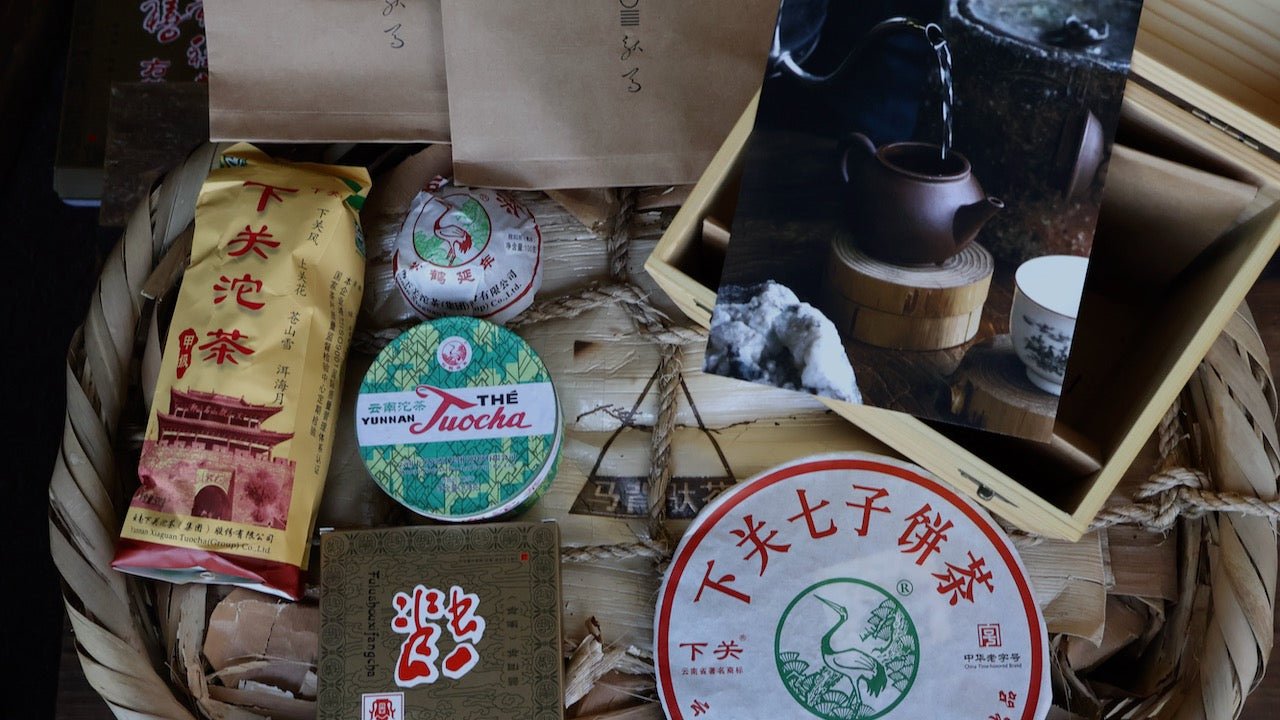A Brief History of Pu Er Tea (Yunnan Post Fermented Tea)

Pu Er is a group of teas which fall under the ‘dark tea’ (嘿茶) category; this category encompasses several styles of fermented teas. Strictly speaking, the term Pu Er should only be used to describe tea that grows in China’s Yunnan Province.
You will often hear the term 'post fermented tea' applied to Pu Er. Traditionally, Pu Er is aged; as time goes by, micro-organisms slowly transform the tea leaves, adding glorious layers of complexity.
The Name: The Chinese characters 普洱 are romanized as ‘Pu Er’ in Pinyin (China’s official system since 1958) or ‘Pu Erh’ in Wade-Giles (an older system). In Mandarin, the pronunciation of 普洱 is quite close to ‘Poo Arr’.
Pu Er is also the name of an ancient tea trading town in southern Yunnan; according to some sources, it was this town that gave the Pu Er name to all the tea grown in this region.
In other countries: you may hear Japanese people refer to Pu Er as プーアル茶 (Pu A Ru Cha), and Koreans as 보이차 (Bo Hee Cha); within China, Cantonese people call it ‘Bo Lay’.
Please consider: tea growers in the countries that border southern Yunnan (Vietnam, Myanmar, Laos) often call their tea ‘Pu Er’ too. We know a good number of both Chinese and Western folks who would strongly disapprove. However, it is worth considering that national border lines in the region have varied significantly over the centuries. What may not be ‘officially' Pu Er today may have been completely acceptable to a tea drinker in the 18th or 19th centuries.

Ancient 'Pu Er' like tree in Ha Giang, Vietnam

Tea lady in Yiwu, Yunnan (2009)
Like so many pieces in China’s multi-millenary culture, Pu Er tea has evolved significantly over time. We have found a few sources that describe its history in the following stages:
ORIGINS: the first known records of tea production in Yunnan date back to the Three Kingdoms period (220-280 CE); they mention ‘pressed tea’, most likely a very rudimentary ancestor of today’s tea cakes. There are more detailed records of tea pressing in the Tang Dynasty (618-907 CE), but focused on the style of green tea that was popular back then. 
SONG & YUAN DYNASTIES (960-1368 CE). These guys increased production of pressed tea. They probably figured out that Yunnan is located in a very remote place and pressed tea can be transported very efficiently by horse.
MING DYNASTY (1368-1644). SAVING ‘PRESSED TEA’. Ming Emperor Zhu Yuanzhang was not thrilled about the very sophisticated nature of Tang tea culture which reserved the enjoyment of tea leaves for an intellectual elite. Thus, he promoted the very simple process of steeping loose leaves in boiling water. Thus, the Chinese abandoned tea cake production in most of the country… but not in Yunnan; that place was too far away and the administration did not seem to care much about it. This simple fact played a crucial role in the development of Pu Er.
THE ‘REFINED’ TEA ERA (1733-1949). In 1733, roughly 100 years into the Qing Dynasty, the first Pu Er tea brand in history was established: Tongxinghao Tea House. Tea businesses emerged right and left and branding became prominent. Pu Er also became an important ‘tribute tea’ for the Imperial Court.
BIRTH OF THE ICONIC ‘MARKS’ (1950-1972). The post-war period and the establishment of the PRC brought massive changes to the tea industry. Some factories started adopting modern machinery and documenting ‘tea recipes’. Some very iconic recipes were branded with ‘marks’ or ‘seals’ (e.g. blue, red…). Some of these cakes are worth real fortunes today.

NEW GENERATION PU ER (1990 to Present). China regained its status as an economic world power; more sophisticated consumers start looking for information about origin, age of the tea trees, handcrafting techniques… Concepts like ‘ancient trees’ were barely mentioned in product packaging before this period. This period witnessed the emergence of private joint-stock enterprises, the introduction of customized teas, and the concept of ancient tree tea. Packaging transitioned from thick tissue paper to thinner paper, and diversified production marked a significant turning point in Pu'er tea's history. Different stages of Pu'er tea development during this period included the emphasis on pure ingredients, regional purity, famous mountain tea, and ancient tree tea.




Comments